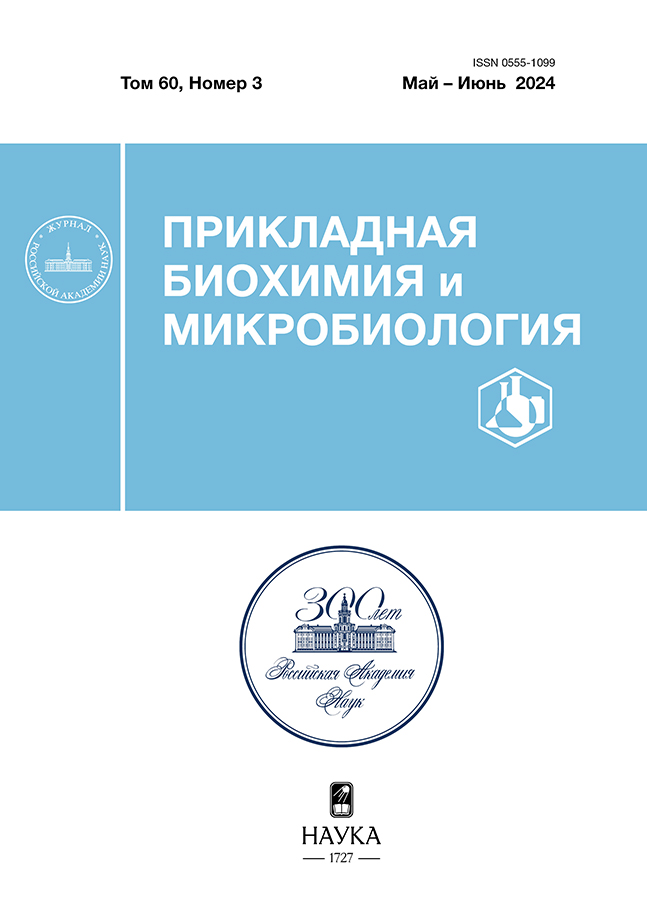Obtaining analogues of fermented milk products from seed meal using new strains of lactic acid bacteria
- Autores: Sinelnikov A.V.1,2, Kolganova T.V.3, Ulanova R.V.2
-
Afiliações:
- Peoples’ Friendship University of Russia (RUDN University)
- Vinogradsky Institute of Microbiology, Federal Research Center of Biotechnology of Russian Academy of Sciencies
- Scriabin Institute of Bioengineering, Federal Research Center of Biotechnology of Russian Academy of Sciencies
- Edição: Volume 60, Nº 3 (2024)
- Páginas: 294-300
- Seção: Articles
- URL: https://cardiosomatics.ru/0555-1099/article/view/674556
- DOI: https://doi.org/10.31857/S0555109924030088
- EDN: https://elibrary.ru/EWMUMU
- ID: 674556
Citar
Texto integral
Resumo
A method has been developed for producing analogues of fermented milk drinks from pumpkin seed meal – a massive waste of oilseed production – using new strains of lactic acid bacteria (LAB) isolated from different samples of kumiss. Based on the results of screening 50 LAB isolates capable of fermenting milk and aqueous meal extracts in a wide pH range, 3 strains with the best growth characteristics were selected. These strains were identified as representatives of the genus Lacticaseibacillus, most closely related to L. rhamnosus and L. casei (with 99.93 and 99.65% similarity in 16S rRNA gene sequences). An optimal scheme for producing drinks has been selected, including: grinding meal, optimized extraction with alkaline solutions, heat treatment of the extract to remove foreign microflora, introduction of inoculum (3–5% v/v) of new LAB strains, ripening at 370C for 10 hours. Compared with the fermented milk product obtained by fermenting milk with the same microorganisms, the drink made from meal extracts was distinguished by the absence of lactose and cholesterol, an increased content of unsaturated fatty acids (2.3 times), protein (1.7 times) and the presence of essential amino acids in proteins. Thus, pumpkin seed meal, which is still ineffectively used, is a good basis for obtaining analogues of fermented milk products with beneficial properties. The developed method for producing lacto-fermented drinks can be adapted for processing other types of meal and cake.
Palavras-chave
Texto integral
Sobre autores
A. Sinelnikov
Peoples’ Friendship University of Russia (RUDN University); Vinogradsky Institute of Microbiology, Federal Research Center of Biotechnology of Russian Academy of Sciencies
Autor responsável pela correspondência
Email: sinelnikov11@ya.ru
Rússia, Moscow; Moscow
T. Kolganova
Scriabin Institute of Bioengineering, Federal Research Center of Biotechnology of Russian Academy of Sciencies
Email: sinelnikov11@ya.ru
Rússia, Moscow
R. Ulanova
Vinogradsky Institute of Microbiology, Federal Research Center of Biotechnology of Russian Academy of Sciencies
Email: sinelnikov11@ya.ru
Rússia, Moscow
Bibliografia
- Silva A.R., Silva M.M., Ribeiro B.D. // Food Res. Intern. 2020. V. 131. № 1. Р. 108972. https://doi.org/10.1016/j.foodres.2019.108972
- Vanga S.K., Raghavan V. // J. Food Sci. Technol. 2018. V. 55. № . 1. P. 10–20.
- Kundu P., Dhankhar J., Sharma A. // Curr. Res. Nutr. Food Sci. J. 2018. V. 6. № . 1. Р. 203–210.
- Mortas M., Besir A., Tok Z., Keles M., Yazici F. // Plant Foods for Human Nutr. 2023. V. 78. P. 358–365.
- Bastıoğlu A.Z., Tomruk D., Koç M., Ertekin F.K. // J. Food Sci. Technol. 2016. V. 53. № . 5. P. 2396–2404.
- Mäkinen O.E., Wanhalinna V., ZanniniE., Arendt E.K. // Crit. Rev. Food Sci. Nutr. 2016. V. 56. № . 3. Р. 339–349.
- Ma W., Zhang C., Kong X., Li X., Chen Y., Hua Y. // Food Biosci. 2021. V. 44. Part A. Р.101416. https://doi.org/10.1016/j.fbio.2021.101416
- Ahmadian-Kouchaksaraei Z., Mohammad M.V., Varidi J., Pourazarang H. // LWT – Food Sci.Technol. 2014. V. 57. № . 1. P. 299–305.
- Hickisch A., Beer R., Vogel R. F., Toelstede S. // Food Res. Internat.. 2016. V. 84. P. 180–188.
- Garro M.S., de Valdez G.F., de Giori G.S. // Food Microbiol.. 2004. V. 21. № 5. P. 511–518.
- Vlaicu P.A, Panaite T.D. // Anim. Biosci. 2022. V. 35. № . 2. Р. 236–246.
- Valdez-Arjona LP, Ramírez-Mella M. // Animals (Basel). 2019. V. 9. № 10. Р. 769. https://doi.org/10.3390/ani9100769
- Ulanova R., Kravchenko I. // Internat. J. Engin. Sci. Innov. Technol. 2013. V. 2. № 6. P. 618–624.
- Уланова Р.В., Кравченко И.К., Горелова О.П., Николаева О.С. Патент на изобретение 2015. RU2557404.
- Afzaal M., Saeed F., Anjum F., Waris N., Husaain M., Ikram A. et al. // Food Sci. Nutr. 2021. V. 9. № 11. Р. 6421–6428.
- Tang H., Ma H., Hou Q., Li W., Xu H., Liu W., Menghe B. // BMC Microbiol. 2020. V. 20. № 1. Р. 1–11.
- Meng Y., Chen X., Sun Z., Li Y., Chen D., Fang S., Chen J. // LWT. 2021. V. 135. Р. 110049. https://doi.org/10.1016/j.lwt.2020.110049
- Филиппова С.Н., Сургучева Н.А., Колганова Т.В., Чербунина М.Ю., Брушков А.В., Мулюкин А.Л., Гальченко В.Ф. // Известия РАН. Сер. биол. 2019. № 3. C. 246–254.
- Остроумов Л.А., Гаврилов В.Г. Биотрансформация лактозы ферментными препаратами β-галактозидазы // Техника и технология пищевых производств. 2013. № . 1. С. 26–30.
- McCleary B.V. // Journal of AOAC International. 2019. V. 102. № . 1. С. 196–207.
- Zheng J, Wittouck S, Salvetti E, Franz C.M., Harris H.M., Mattarelli P.et al. // Int. J. Syst. Evol. Microbol. V. 70. № 4. P. 2782–2858.
- Śliżewska K, Chlebicz-Wójcik A. // Biology (Basel). 2020. V. 9. № 12. Р. 423. https://doi.org/10.3390/biology9120423.
- Sawatari Y, Yokota A. // Appl. Environ. Microbiol. 2007 V. 73. № 12. P. 3909–3915.
- Kluczkovski A., Lima N., Oliveira, M.K. // J. Food Proc. Preserv. 2017. V. 41. № 5. Р. 13147. https://doi.org/10.1111/jfpp.13147.
- Jiménez‐Martínez C., Hernández‐Sánchez H., Dávila‐Ortiz G. // J. Sci. Food and Agricult. 2003. V. 83. № 6. Р. 515–522.
- Уланова Р.В., Николаев Ю.А., Колпакова В.В., Галуза О.А., Синельников А.В. Патент РФ 2022. № RU2784723.25.
- Silva D, Nunes P, Melo J, Quintas C. // AIMS Microbiol. 2022. V. 8. № 1. Р. 42–52.
- Shahein M.R., Atwaa E.S.H., Alrashdi B.M., Ramadan M.F., Abd El-Sattar E.S., Siam A.A.H. et al. // Fermentation. 2022. V. 8. № . 5. Р. 223. https://doi.org/10.1016/j.fbio.2021.101416
- Vlaicu P.A., Panaite T.D. //Animal Biosci. 2022. V. 35. № 2. Р. 236–246.
Arquivos suplementares













